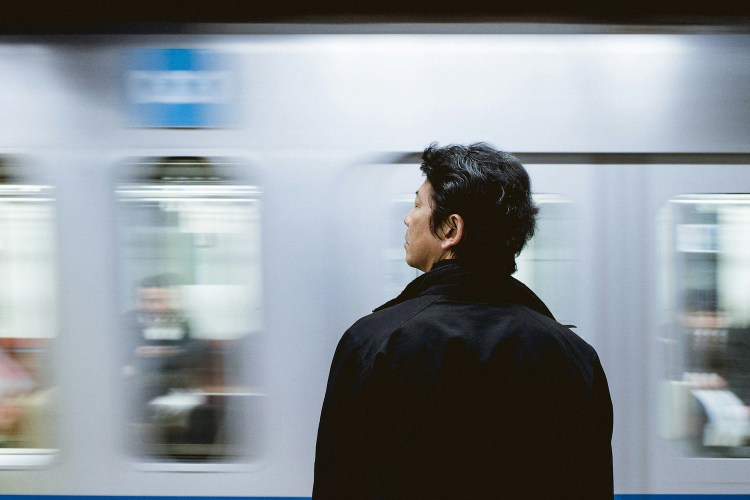Those who dismiss it as flyover country likely picture wide open spaces — flat and unexciting. Those who know slightly better but haven’t spent any serious time pondering the area probably first think of Frank Lloyd Wright or big glass buildings. But the architecture in the Midwest is so much more: weird, innovative, sophisticated and above all, diverse, ranging from the oddball designs of Bertrand Goldberg (who designed Chicago’s famous Marina Towers) and the socially conscious work of Lillian Leenhouts to unheralded anonymous gems like flea markets, grain silos, rest stops, indigenous mounds and parking lots.
Zach Mortice has experienced it all, from playing in grain silos during his childhood on a farm in Iowa to attending a birthday party in a Frank Lloyd Wright house outside his current home of Chicago. The design journalist edited Midwest Architecture Journeys, a collection of pieces by more than 20 architects, critics and journalists, with the aim of highlighting the area’s lesser-known architectural treasures and championing a region that often gets overlooked in general. (“You don’t hear about them, but they’re really rigorous and adventurous types of buildings, and that’s maybe sort of a metaphor for the Midwest,” he says.)
InsideHook caught up with Mortice to talk about some of the area’s most underrated architects, finding beauty in something as simple as a gas station and the best architectural destinations outside of Chicago worth taking a road trip to see.
Tell me a little about the inspiration behind the book.
What we wanted to do was work on a couple different registers. On the one hand, we wanted to shed some light on vernacular expressions of the Midwest, kind of architecture without architects — there’s a piece about grain silos and grain elevators, a piece about flea markets, highway rest stops, so on and so forth — as well as architecture just outside the main, sort of Frank Lloyd Wright b-sides, Wright College which is one of Bertand Goldberg’s last major commissions and is really understudied, this piece about the First Church of Deliverance on the South Side of Chicago which is this really kind of quirky and amazing adaptively reused hat factory designed by one of the first licensed African-American architects in the state of Illinois. So really the kind of things that had some sort of professionalized design hand on them but for reasons of economics, history, classism, racism maybe didn’t get their story told on par with some of the greatest hits.
How important was it to you to maintain that balance between pieces highlighting those professional designs and pieces like the flea market one as you were selecting what went into the book?
That was really important. That’s an issue you can look at in any geographic region; there are always places and things that determine our perception of the built environment that someone who doesn’t spend a lot of time thinking about [elaborate design] put together, be that a gas station or a logging mill or in the Midwest, a grain silo. I grew up on a farm in Iowa until I was eight, so I was very well-accustomed to grain silos. They were probably my first experience and understanding of monumental architecture or infrastructure in any capacity. I remember when my dad would climb to the top of these, it was exciting, but I was also nervous because he was way up there and I was a teeny tiny kid. I remember playing in partially filled grain silos three stories up in these monumental mounds of corn. As a four-year-old, that’s like climbing on top of the Sears Tower in a way. I wanted to kind of connect back to those personal touchpoints for all types of Midwestern experiences, whether you’re very well ensconced in living in it as I have most of my life or if you’re just passing through a rest stop on I-80.

What do you think is the biggest misconception about Midwestern architecture?
I’m not sure there’s any one completely dominant misunderstanding. There are a lot of little ones for sure. One thing that gets buried in some contexts that the Midwest is really kind of revered for ruralism. When people think of the Midwest they think of small towns and grain silos. Those are all very important and meaningful, and they say a lot about the economy, but I mean, the city of Chicago for example sort of invented the modern contemporary city in a lot of ways — the skyscraper and everything that that’s kind of allowed since. So it’s a chance to look to that. And I think it’s really just important to step back and point to the sophistication of the work. Bertrand Goldberg again I think doesn’t always quite get his due in the history of regional modernist practitioners coming out of the Miesian school. I think maybe one misconception is the extent to which the Midwest is progressive or conservative. It’s pretty regular for coastal folks to be mad at the Midwest for Trump or whatever, and Rashida Tlaib and Ilhan Omar are Midwestern people. I live in Chicago, and we’ve got six socialists on our city council. That’s not really happening anywhere else. And there’s a corollary to that in architecture and in the book. There’s a piece about Lillian Leenhouts. She was a Milwaukee architect and she was an ecosocialist before as many people were really talking about that and were aware of it as a political force. Milwaukee has a pretty rich history of grassroots activism, and Lillian Leenhouts really organized her practice around that idea. She was very, very involved with the civic infrastructure in the city. She was on many, many committees looking at many elements of how the city works. Some of the projects she designed were also an expression of her socialist beliefs. They were very eco-friendly for the day. So there’s a really rich body of work about the Midwest’s assigned level of progressivism, I think.
Was there anything that you weren’t familiar with beforehand that took you by surprise as you were putting together the book?
Yeah, that Lillian Leenhouts thing was really kind of a bolt from the blue. I really hope it kicks off new rounds of scholarship about Leenhouts, because I think it’s such a vital piece and a conversation we have to have right now in this social and cultural moment. The underground buildings of Minneapolis-St. Paul, that was fascinating. I didn’t know a single thing about them. It’s this really fascinating instance of architects within living memory coming up and executing really grand, ambitious plans. We’re kind of told we can’t do that now, or if we’re going to do that, the private sector has to do it, but this was a public university, the University of Minnesota, pushing that forward. There’s kind of a metaphor there, because these buildings, they’re literally underground. So you don’t hear about them, but they’re really rigorous and adventurous types of buildings, and that’s maybe sort of a metaphor for the Midwest. It’s kind of under the radar, but the ambition and the clarity and the power is still really there.

Let’s talk a little bit about Bertrand Goldberg. You mentioned he doesn’t really get his due, and yet a place like Wright College is so delightfully weird. Why do you think it isn’t as well-known?
It’s definitely delightfully weird. I think the really fascinating thing about it is it has this pretty intense, specifically formal quality to it, but Goldberg, he wasn’t like a willful, napkin-sketcher kind of guy. In terms of why it’s not as well-known, it’s pretty far out there in the bungalow belt in Chicago, so it’s not next door to Marina City for example. Folks aren’t gonna automatically stop by. Goldberg in general kind of suffered because he doesn’t have a ton of public work. He did lots of housing and things, lots of places that you need a key to get into. So I think by association that’s kept him under the radar, even though this building’s very accessible, anyone can go in. Goldberg didn’t teach, so he didn’t quite build up the crop of acolytes that Frank Lloyd Wright did. He was in Chicago, he was born in Hyde Park, and for that reason he’s absolutely revered in Chicago. Chicagoans love people who stick close to home and fly that banner. We really respect that. But he geographically had some distance from the big media apparatus that was and still is kind of in New York. Those are the main reasons. It’s such a one-off in so many ways. It’s got this kind of ’60s gee-whiz sci-fi optimism but it was in the ’90s. So it was always kind of an oddball. You can imagine if you look at it, you wouldn’t know what continuum to place it in. It’s one of my favorite places to be.
Kind of going off of that, if somebody’s in Chicago and they want to take a little road trip to check out some more great architecture in the Midwest outside of the city, what would you recommend?
So Columbus, Indiana has this incredible stock of midcentury modernist buildings. Cummins Engine Company there, one of their CEOs in the ’50s and ’60s, Irwin Miller, he kind of caught the holy spirit for midcentury modernist architecture, and he said to various schools, churches, fire departments, “We’ll pay the design fees for this pre-approved and excellent list of architects if you hire them.” So it’s Harry Weese, it’s I.M. Pei, Eero and Eliel Saarinen and so on in southern Indiana, south of Indianapolis. In many cases, those buildings have aged very, very well. It’s basically an architectural petting zoo. Fairly small town, walkable, pretty charming downtown. You can see an I.M. Pei library across from an Eliel Saarinen church. Some of their elementary schools are really outstanding. There’s a John Johansen elementary school — Google pictures of Smith Elementary in Columbus, Indiana. It’s one of those buildings that reminds you that so many choices made in the built environment are kind of just old stand-bys, sort of repeating, and it reminds you that architecture can be anything you want it to be, and this architect basically reimagined everyone’s idea of space. A somewhat similar idea, the University of Cincinnati through the aughts and ’90s were very interested in commissioning contemporary architecture, so lots of important architects are represented there. Thom Mayne, Bernard Tschumi, so on. It’s also sort of an architectural petting zoo, but it’s sort of based in a different era and we’re not really far away enough from it to know if these are going to age quite as well as the things in Columbus, Indiana. But it’s definitely sort of a snapshot in time of where architecture was about a decade ago. These are pretty avant garde buildings, pretty challenging buildings for this public university.
Another Midwest architecture destination that rarely gets its due is Marktown, Indiana — just across the state line from Illinois — which was a factory town designed by Chicago architect Howard Van Doren Shaw. Built to house workers toiling at a steel pipe and tube factory, the homes have a signature twinned gables and hipped roofs. They’re arranged in duplexes and quadplexes, made of brick but covered in stucco, painted in pastels. The streets are walkable and narrow — so narrow that people park their cars on this sidewalk and walk in the streets, which actually works quite well. Marktown is basically marooned in a sea of heavy industry, as BP has been purchasing these historic homes and demolishing them. Its setting is fascinating on its own, but also ominous. It’s one of the most vulnerable and historic places in the region, and it largely exists in the shadow of Chicago’s Pullman former factory town neighborhood, which is now a national monument. Losing Marktown would mean losing a singular example of well-designed and constructed worker housing by a regionally historic architect that was experimenting with new forms of urban planning, and the destruction of another working class community. There are preservationists focusing their time of Marktown. But there are few countervailing forces that can halt a global corporation like BP’s advance, so I always tell people to go to Marktown as soon as they can, because its existence is not guaranteed.

What do you ultimately hope that people get out of this book in terms of understanding the Midwest and its architecture?
As this project came together, one thing I noticed is that so much of the best work here in the Midwest is relatively accessible. I would imagine that in New York, the Paul Rudolph penthouse apartments are really tough to get into. But here there are Frank Lloyd Wright houses on sale on the South Side for $175,000. The best work here is really accessible, and the pieces in the book kind of reaffirm that. I was at a toddler’s birthday party at a different Frank Lloyd Wright house in River Forest-Oak Park, and I got there and I realized I’ve never been in a space like this where I didn’t have someone with like white gloves following me around making sure I didn’t knock the furniture. And I kind of celebrated by drinking half the wine at the party. [laughs] It was a good little victory there. I was most amazed that a Frank Lloyd Wright house had dropped so much in price that someone I knew could conceivably afford it. So I would hope this book gets people to recognize that and it inspires them to get out and see these places for themselves.
This article appeared in an InsideHook newsletter. Sign up for free to get more on travel, wellness, style, drinking, and culture.
























